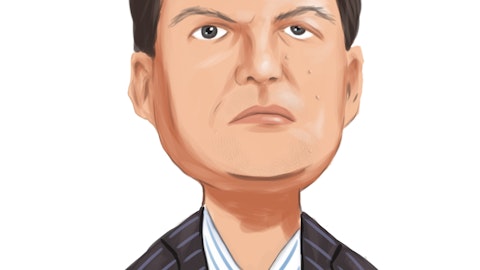And I think the things you’re going to see are continued really solid progress on the fixed asset repricing, major asset categories on the fixed side this quarter are seeing, again, sequential increases since Q3 and we’ll expect to see that continuing on, particularly in the higher for longer scenario. Even as we do see data continuing to trend as well, it will be accretive to the overall spread throughout the course of next year we think. We will also benefit, as we’ve noted before, during 2024 from a gradual reduction in the negative carry from the received fix swap hedge portfolio, we estimate roughly 5 basis points throughout the course of next year on that benefit, mainly in the second half of the year. So I would say a couple that flat to rising NIM with growth in loans, growth in earning asset that, as I noted, it will drive overall NII dollars higher.
We’ll get more precise with guidance as we get into January. But those are the major drivers that we’re seeing at this point.
John Pancari: Very helpful, Zach. Thank you for that. And then separately on credit. Criticized loans up 17% linked quarter. It looks like — and I believe you alluded to in your comments, a lot of that was commercial real estate. Can you — and I know you added to your reserve and commercial real estate nonperformers are also up pretty sharply. Was there a dedicated effort to scrub the portfolio that you’re working through your exposures there that drove a lumpier move here? Or is this the deterioration that’s starting to take shape as we all expect in this sector?
Rich Pohle: Hi, John, it’s Rich. Let me start with that, and then I can turn it over to Brendan to give you a little bit more color on what happened in the third quarter. So if you think back to Q2, our NPA level was at 46 basis points, which was the lowest level we’ve had since the GFC, and we’ve had eight consecutive quarters of declines, totaling over $450 million since then. The Q3 level that we’re at today, 52 basis points is right around where we were this time last year. So to me, it’s not at a level that’s concerning to your point around being proactive. We have been a lot of the adds to nonaccrual that we had in the quarter were discretionary. We think about two-thirds of our commercial NPLs are current on their principal and interest.
The [crick] (ph) class is a similar story. We had reductions in five of the six previous quarters. And as you talk about credit normalizing, you would expect to see an increase in crick class down from that. So I wouldn’t categorize the movements as huge jumps. I think it’s just a normal position at very low levels for us. But Brendan, why don’t you give a little bit of insight into the Q3 specifics.
Brendan Lawlor: Sure. Thanks, Rich. To provide us a little bit more color approximately — per crick class, approximately 60% of the increase was focused in commercial real estate and our ABL group. There are two places you’d expect to see higher levels. On the FDA side, it was split more equally between commercial real estate and C&I. For both NPA and crick class, as you noted, the real estate exposure was focused mostly in office. And on the C&I side, beyond the ABL concentration I mentioned, there really weren’t material concentration. So I think what you’re seeing in the numbers, as Rich said, it’s just a bounce off a very low bottom.
John Pancari: Okay. Thank you. Appreciate the detail.
Operator: Our next question comes from the line of Ebrahim Poonawala with Bank of America.
Ebrahim Poonawala: Hi. Good morning.
Steve Steinour: Good morning, Ebrahim.
Ebrahim Poonawala: Just maybe a question for you, Steve. I think — I mean, you all have talked about being transported, there are banks that are talking about coming back to loan growth next year. But I’m just wondering if there’s going to be a ton of loan demand to speak of for banks to lend into. Just give us a sense of what you seeing across your footprint? Where that loan demand is coming from? Or are you seeing customers get increasingly cautious?
Steve Steinour: Ebrahim, great question. Thank you. I believe there’s a growing cautiousness in what’s going on in Israel and the Middle East, what’s going on in Washington. We’ve got a UAW strike that does not have an apparent resolution. And I think, businesses are reacting to that. 99% of our customer base, privately owned companies rates are up. They’re using their liquidity, but the uncertain economic outlook and where rates are going, all sort of are headwinds to the next round of growth. Having said that, our businesses are doing well. We’ll have good growth. We’ll be within guidance that we gave you, that Zach gave you earlier in the year, we will be up about 5% year-over-year. And we’ll continue to see growth next year, I believe, in a couple of areas in particular.
Our distribution finance is a powerful engine. It seasonally reduced this quarter. It will be up in the fourth quarter, and we expect to continue to grow that by winning new business. We are a significant equipment finance lender. And more and more onshoring, more automation, there’ll be continued demand, albeit probably not at the levels we saw in 2022 and before. That will play well. And we’re top 10 asset-based lender. So all of those asset related finance activities should do well in this environment. And as you know, we are a huge small business bank. The small businesses will need more support and we’ll be there for them. And those will be sources of growth. But there’s an overall more cautious outlook within our customer base, just that will have some moderate impact on, I think, on overall loan demand next year.
Ebrahim Poonawala: Got it. That’s helpful. And I guess a follow-up. Zach, you mentioned solid increases in fixed asset portfolio yield as they repriced. Just talk to us in terms of when these are coming up for repricing? Is it just kind of playing out contractually? If there’s some negotiation in terms of the spreads that are narrowing at the time of repricing of these fixed rate loans? And is that kind of impacting credit trends, are some of these borrowers looking a bit worse in terms of their ability to service the debt post repricing?
Zach Wasserman: Yes. Great questions, and let me address those. So what I’d say is, in terms of the trajectory on asset yield, taking a step back, over 200 basis points through the cycle to date, and it’s really been a couple of things, most notably an intentional outcome that we’ve had in terms of how we’re incrementally driving new loan production into — and really driving for higher returns, which also is often higher NIM. And so we’re seeing that come through in a lot of the areas where we’re actively modulating and optimizing indirect auto, for example, is a great example that fuels up tremendously on the [indiscernible] course of the cycle. It’s also though just a natural outcome of the structure of the balance sheet.




